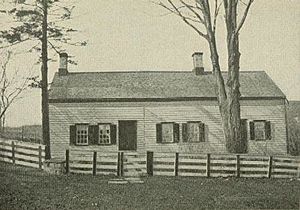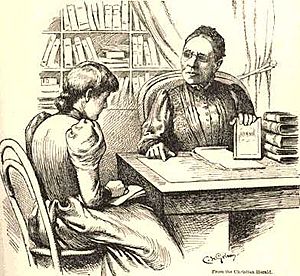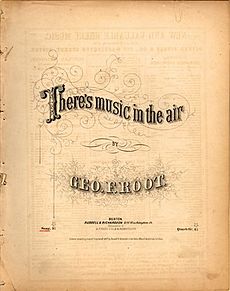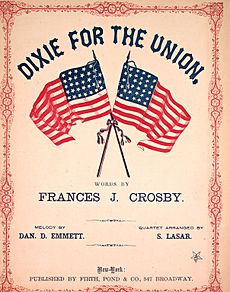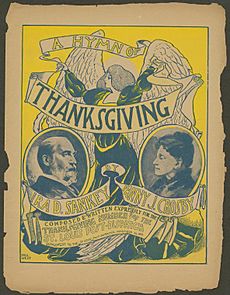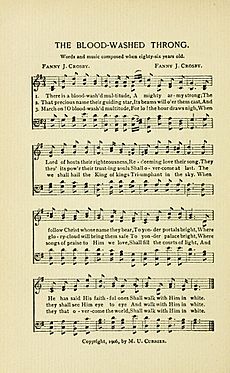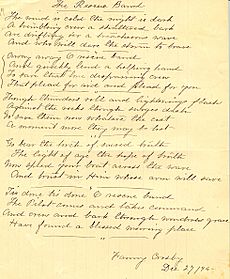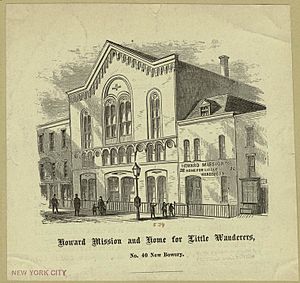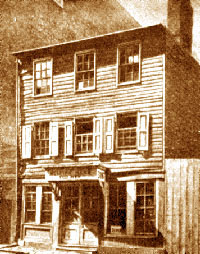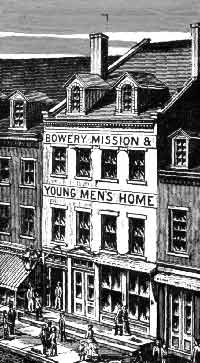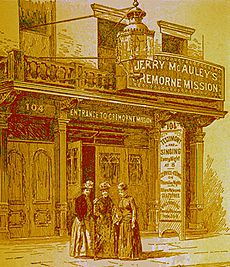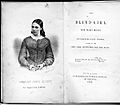Fanny Crosby facts for kids
Quick facts for kids
Fanny Jane Crosby
|
|
|---|---|
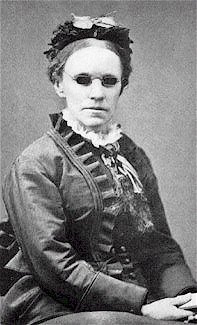
Crosby in 1872
|
|
| Born |
Frances Jane Crosby
March 24, 1820 Brewster, New York, U.S.
|
| Died | February 12, 1915 (aged 94) Bridgeport, Connecticut, U.S.
|
| Occupation | Lyricist, poet, composer |
| Years active | 1844–1915 |
| Spouse(s) |
Alexander van Alstyne, Jr.
(m. 1858; died 1902) |
| Children | 1 |
| Signature | |
Frances Jane van Alstyne (born Crosby; March 24, 1820 – February 12, 1915), known as Fanny J. Crosby, was an American mission worker, poet, and songwriter. She wrote over 8,000 hymns and gospel songs. More than 100 million copies of her songs have been printed. She was also known for her teaching and her rescue mission work. By the late 1800s, almost everyone knew her name.
Fanny Crosby was called the "Queen of Gospel Song Writers." She was also known as the "Mother of modern church singing in America." Most American hymnals (songbooks for churches) include her work. Her gospel songs were very important for church revivals. Ira Sankey said that her hymns helped the success of the Moody and Sankey church campaigns. Some of her most famous songs are "Pass Me Not, O Gentle Saviour", "Blessed Assurance", "Jesus Is Tenderly Calling You Home", "Praise Him, Praise Him", "Rescue the Perishing", and "To God Be the Glory". To make sure publishers would use her songs, Fanny Crosby used almost 200 different pseudonyms (fake names) during her career.
Crosby also wrote over 1,000 regular poems. She published four books of poetry and two popular books about her own life. She helped write popular non-religious songs, as well as political and patriotic songs. She also wrote at least five cantatas (musical stories) based on the Bible and patriotic themes. One of these was The Flower Queen, which was the first non-religious cantata by an American writer. She cared deeply about Christian rescue missions and was known for her public speaking.
Early Life and Education
Frances Jane Crosby was born on March 24, 1820, in a village called Brewster, New York. This was about 50 miles (80 km) north of New York City. She was the only child of John and Mercy Crosby. Her father died in November 1820 when Fanny was only six months old. So, her mother and grandmother, Eunice Paddock Crosby, raised her. These women taught her strong Christian values. They helped her memorize many parts of the Bible. She became an active member of the John Street Methodist Episcopal Church in Manhattan.
When Fanny was six weeks old, she got a cold. This led to an eye infection. Doctors applied mustard plasters to treat it. Fanny believed this treatment damaged her optic nerves and caused her blindness. However, modern doctors think she was likely born blind. Her parents might not have noticed it until later.
When Crosby was three, her family moved to North Salem, New York. In April 1825, a surgeon said her blindness was permanent. At age eight, Fanny wrote her first poem about being blind. She later said, "It seemed intended by the blessed providence of God that I should be blind all my life, and I thank him for the dispensation." She also said, "If perfect earthly sight were offered me tomorrow I would not accept it." She believed her blindness helped her focus on God and her music.
In 1828, Fanny and her mother moved to Ridgefield, Connecticut. Fanny memorized five chapters of the Bible every week from age 10. Her grandmother and later a Mrs. Hawley encouraged her. By age 15, she knew the four gospels, the Pentateuch, the Book of Proverbs, the Song of Solomon, and many Psalms by heart. Around this time, she started attending Methodist church services. She loved their hymns.
Fanny Crosby started at the New York Institution for the Blind (NYIB) in 1835. She was almost 15 years old. She studied there for eight years and then stayed for two more years as a graduate student. During this time, she learned to play the piano, organ, harp, and guitar. She also became a good singer.
Early Career and Public Speaking
After finishing her studies at the NYIB in 1843, Fanny Crosby joined a group of people who spoke up for education for the blind. She went to Washington, D.C.. She was the first woman to speak in the United States Senate when she read a poem there.
Crosby and other students from the NYIB gave a concert for Congress on January 24, 1844. She read a poem she wrote. It asked for a school for the blind in every state. Many people, including John Quincy Adams, praised her. She also spoke to the New York state legislature in 1851. In April 1846, she spoke to a joint meeting of the United States Congress. She asked for support for blind education. She also performed at the White House for President Polk and his wife.
In 1846, Crosby became a teacher at the NYIB. She taught grammar, public speaking, and history. She stayed there until just before her wedding in 1858. While teaching, she became friends with Grover Cleveland, who later became a US president. He was 17 at the time. They spent many hours together, and he often wrote down the poems she told him. He even wrote a recommendation for her 1906 autobiography.
Christian Faith and Mission Work
Fanny Crosby was a long-time member of the Sixth Avenue Bible Baptist Church in Brooklyn, New York. She served as a Baptist missionary, deaconess, and lay preacher. She wrote hymns with her minister, Robert Lowry, like "All the Way My Savior Leads Me".
In 1849, there was a cholera outbreak in New York City. Fanny stayed at the NYIB to help nurse the sick. Later in her life, she became more involved in helping the poor.
Crosby attended different churches. She went to the Plymouth Church of the Pilgrims in Brooklyn Heights. She also worshipped at the North West Dutch Reformed church and the Central Presbyterian Church. In later life, she said one of her favorite preachers was Theodore L. Cuyler.
Crosby was friends with important people in the Christian holiness movement. This included Phoebe Palmer Knapp, who helped write "Blessed Assurance". She often visited the Methodist camp grounds at Ocean Grove, New Jersey. She would speak there and meet her admirers. In 1877, Crosby met William J. Kirkpatrick, a famous gospel song composer. She called him "Kirkie" and wrote many hymns with him. In 1887, she officially joined the Cornell Memorial Methodist Episcopal Church.
Writing Career
Fanny Crosby's first published poem was printed by P. T. Barnum in The Herald of Freedom. A Scottish brain expert, George Combe, said she was a "born poetess." This encouraged her to write even more.
In 1841, the New York Herald published her poem about the death of President William Henry Harrison. This started her writing career. Her poems were often published in magazines like The Saturday Evening Post.
Crosby was not sure about publishing her poems at first. But she agreed because it would help the Blind Institution raise money. Her first book, A Blind Girl and Other Poems, came out in 1844. It included "An Evening Hymn," which she called her first published hymn. In 1853, her book Monterey and Other Poems was published. It had poems about the Mexican–American War and the Great Famine of Ireland.
Popular Songs and Cantatas
Fanny Crosby was inspired by the success of Stephen Foster's songs. She and George F. Root wrote at least 60 non-religious "people's songs" or parlour songs between 1851 and 1857. Some were for popular minstrel shows. Their first successful song was "The Hazel Dell" (1853). It was a hit and sold over 200,000 copies of sheet music.
Their song "There's Music in the Air" (1854) also became very popular. It was listed as one of the most popular songs of 1854. It was in songbooks until the 1930s and became a college song at Princeton University. Another popular song was "Rosalie, the Prairie Flower" (1855), about a young girl's death. It sold over 125,000 copies. Fanny Crosby usually only got $1 or $2 for each poem she wrote. The composer or publisher kept all the rights.
Between 1852 and 1854, Crosby wrote the stories for three musical works called cantatas for Root. Their first was The Flower Queen; The Coronation of the Rose (1852). It is often called "the first non-religious cantata written by an American." It was like a popular small opera for teenage girls. It was performed about 1,000 times in the United States in its first four years.
Political and Patriotic Songs
Crosby wrote political songs, including ones about battles in the Mexican–American War and the American Civil War. She was a strong supporter of ending slavery. She supported Abraham Lincoln and the Republican Party. After the Civil War, she supported the Grand Army of the Republic.
During the Civil War, Crosby wrote many poems supporting the Union cause. This included "Dixie for the Union" (1861). She also wrote "There is a Sound Among the Forest Trees" with music by William B. Bradbury. This song encouraged people to join the Union forces. She also wrote "Song to Jeff Davis" for Jefferson Davis, the president of the Confederate States. It showed her belief in the Union's cause.
Marriage and Family Life
In 1843, Fanny Crosby met Alexander van Alstyne Jr. He was also blind and studied at the NYIB. They got married on March 5, 1858. Fanny kept using her maiden name, Crosby, for her writing. But she used her married name, van Alstyne, on all legal papers.
In 1859, the van Alstynes had a daughter named Frances. She died soon after birth. Some people think it was typhoid fever, but it might have been SIDS. Some believe Crosby's hymn "Safe in the Arms of Jesus" was inspired by her daughter's death. Fanny rarely spoke publicly about being a mother.
After their daughter's death, Alexander became more private. Fanny and Alexander lived separately for many years, but they stayed in touch. Fanny said they "maintained an amiable relationship" and sometimes worked together. Alexander played the organ at churches and gave music lessons. Fanny often gave away any money they didn't need for daily life.
In 1896, Crosby moved to Brooklyn and lived with friends. Her husband, Alexander, died on July 18, 1902. Fanny was too sick to attend his funeral.
Career in Writing Hymns
Fanny Crosby was one of the most productive American sacred (religious) songwriters of the 1800s. She wrote almost 9,000 hymns. She used many different pen names (fake names) because publishers wanted to hide how many songs she wrote for them.
It's thought that books with her lyrics sold 100 million copies. However, Fanny Crosby was often paid very little for her hymns, usually just one or two dollars. The rights to the songs usually went to the music composer or publisher. In her 1906 autobiography, Crosby said she wrote her hymns "in a sanctified manner," not for money. She said she donated her earnings to good causes.
Crosby wanted her hymns to help a million people find Christ. She prayed for this every time she wrote a hymn. She kept records of people who said they were helped by her songs.
Her hymns were popular because they focused on religious experiences, emotions, and personal stories. They showed a loving relationship between the believer and Christ. This was different from older hymns that focused more on people's sins.
Her hymns were published by many famous companies:
- William B. Bradbury published her hymns in his Golden Censer (1864). This book of Sunday School hymns sold three million copies.
- For many years, Crosby agreed to write three hymns a week for Hubert Main. His company, Biglow and Main, bought 5,900 poems from her. They published almost 2,000 of them.
- Methodist publisher Philip Phillips published about 525 of her hymns.
Musical Partners
Howard Doane was a businessman who became Crosby's main partner in writing gospel music. He wrote melodies for about 1,500 of her lyrics. Crosby trusted Doane with the business side of her songs.
In 1868, Crosby met Phoebe Palmer Knapp. Phoebe was married to Joseph Fairchild Knapp, who helped start the Metropolitan Life Insurance Company. Phoebe and Fanny worked together on hymnals. Their most famous song together was "Blessed Assurance". Crosby wrote the words for it in 1873, for a tune Phoebe Knapp had written.
From 1871 to 1908, Crosby worked with Ira Sankey. He helped make her "a household name to Protestants around the world." Sankey and evangelist Dwight L. Moody helped spread many of Crosby's hymns in the United States and Britain. Crosby and Sankey were close friends. They often wrote hymns together at Sankey's home.
How Crosby Wrote Hymns
Crosby described her hymn-writing process: "It may seem a little old-fashioned, always to begin one's work with prayer, but I never undertake a hymn without first asking the good Lord to be my inspiration." She could write six or seven hymns a day. She composed all her poems and hymns in her mind. She could work on up to twelve hymns at once before telling them to someone else to write down. Her husband, "Van," or her half-sister, Carolyn Ryder, or her secretary, Eva C. Cleaveland, usually wrote down her lyrics. While Crosby had music training, she usually did not write the melodies for her lyrics. In 1903, she said "Spring Hymn" was the only hymn for which she wrote both the words and music.
Some people have criticized Crosby's hymns for being too emotional or simple. But many people loved them because they were heartfelt and easy to understand. They spoke to people's feelings and hopes. Many of her hymns are still sung today.
Rescue Missions and Later Life
Fanny Crosby wanted to be known mostly as a rescue mission worker. Many of her hymns came from her work in city missions. These include "More Like Jesus" (1867), "Pass Me Not, O Gentle Saviour" (1868), and "Rescue the Perishing" (1869). "Rescue the Perishing" became a very popular song for mission work.
Crosby lived for decades in poor areas of Manhattan. She saw the great needs of immigrants and poor people in the city. She was very eager to help them through urban rescue missions and other charity groups. She said, "From the time I received my first check for my poems, I made up my mind to open my hand wide to those who needed assistance." She never charged for her speeches and often refused payment. What little money she did accept, she usually gave away. She and her husband also held concerts and gave half the money to the poor.
She wrote "More Like Jesus Would I Be" in June 1867 for the anniversary of the Howard Mission and Home for Little Wanderers. This was a mission for children in Manhattan. She was inspired to write "Pass Me Not, O Gentle Saviour" after speaking at a prison in Manhattan in 1868. Prisoners asked the Lord not to pass them by. This hymn became popular worldwide after Ira Sankey used it in his crusades in Britain in 1874.
In July 1869, Crosby attended meetings at the New York City Mission. A young man became a Christian after hearing her speak. This inspired her to write "Rescue the Perishing."
Later Years (1880–1915)
In 1880, at age 60, Crosby decided to dedicate the rest of her life to helping the poor. She lived in a simple apartment near one of Manhattan's worst slums. She became more involved in various missions and homes.
For the next 30 years, she worked at city rescue missions. She was known as "Aunty Fanny." She helped at places like the McAuley Water Street Mission and the Bowery Mission. She also spoke at YMCAs, churches, and prisons about the needs of the urban poor. She strongly supported Frances Willard and the Woman's Christian Temperance Union.
From about 1880, Crosby supported the Helping Hand for Men in Manhattan, also known as the Water Street Mission. This was "America's first rescue mission." Crosby often visited the Water Street Mission, talking and counseling people there.
Crosby supported the Bowery Mission in Manhattan for 20 years. She often attended and spoke at their evening meetings. She would also read a poem she had written for the occasion. Many of these poems were set to music by Victor Benke, the Mission's organist.
Jerry and Maria McAuley started the Cremorne Mission in 1882. It was in a tough area of Manhattan. Crosby attended the nightly services there. Gospel songs she wrote with Doane were often sung.
Crosby's hymn writing slowed down in her later years. But she continued to speak and do missionary work among the urban poor almost until she died. She was very famous and often met with presidents and other important people.
Some of her rich friends, like Doane, Sankey, and Phoebe Knapp, often helped her financially. But she still gave generously to those less fortunate. Her publisher, The Biglow and Main Company, paid her a small amount each week.
In 1900, Crosby became ill with a heart condition. Her half-sisters convinced her to move to Bridgeport, Connecticut. She lived with her widowed half-sister Julia and her younger sister Caroline. She changed her church membership to the First Methodist Church of Bridgeport in 1904. Her husband "Van" died on July 18, 1902. Phoebe Knapp paid for his burial.
Passing of Friends and Public Appreciation
Crosby's sister Carrie died in July 1907. Phoebe Knapp died in July 1908. Weeks later, Ira Sankey died. He had just sung "Saved by Grace," one of Crosby's most popular songs.
On May 2, 1911, Crosby spoke to 5,000 people at Carnegie Hall. The crowd sang her songs for 30 minutes before she spoke. On her 94th birthday in March 1914, people across the country celebrated "Violet Day" to honor her.
Death and Legacy
Fanny Crosby died in Bridgeport on February 12, 1915, at age 94. She had been ill for six months. She was buried at Mountain Grove Cemetery in Bridgeport, CT, near her mother. At her request, her family put a very small tombstone with the words: "Aunt Fanny: She hath done what she could; Fanny J. Crosby."
Crosby said her interest in "public affairs has never stopped." She met important leaders like Henry Clay and President Polk. She believed they were great men who taught important lessons about national honor and democracy.
Fanny Crosby Day
On Sunday, March 26, 1905, "Fanny Crosby Day" was celebrated in churches around the world. It honored her 85th birthday. She attended the First Baptist Church in Bridgeport and spoke there.
In March 1925, about 3,000 churches in the United States observed Fanny Crosby Day. This was to remember the 105th anniversary of her birth.
Fanny Crosby Memorial Home for the Aged
Fanny Crosby left money in her will to help older men who had no place to live. In 1923, the King's Daughters of the First Methodist Church of Bridgeport started raising money for the Fanny Crosby Memorial Home for the Aged. The home opened on November 1, 1925. It operated until 1996 when it was given to the Bridgeport Rescue Mission.
A historic marker was placed on October 8, 1934, near her birthplace in Doansburg, New York. A large memorial stone was dedicated on May 1, 1955, by her friends. It was much bigger than her original gravestone, even though she asked for a small one. It had the first verse of "Blessed Assurance" on it.
Other Honors
Fanny Crosby was added to the Gospel Music Hall of Fame in 1975. She is known as the "Queen of Gospel Song Writers." In 2010, songwriter George Hamilton IV toured churches, celebrating her great contribution to gospel music. Her hymns are still included in many modern hymnals today.
Images for kids
-
Frontispiece of The Blind Girl (1844)
See also
 In Spanish: Fanny Crosby para niños
In Spanish: Fanny Crosby para niños


